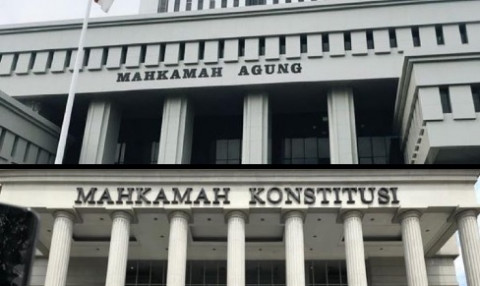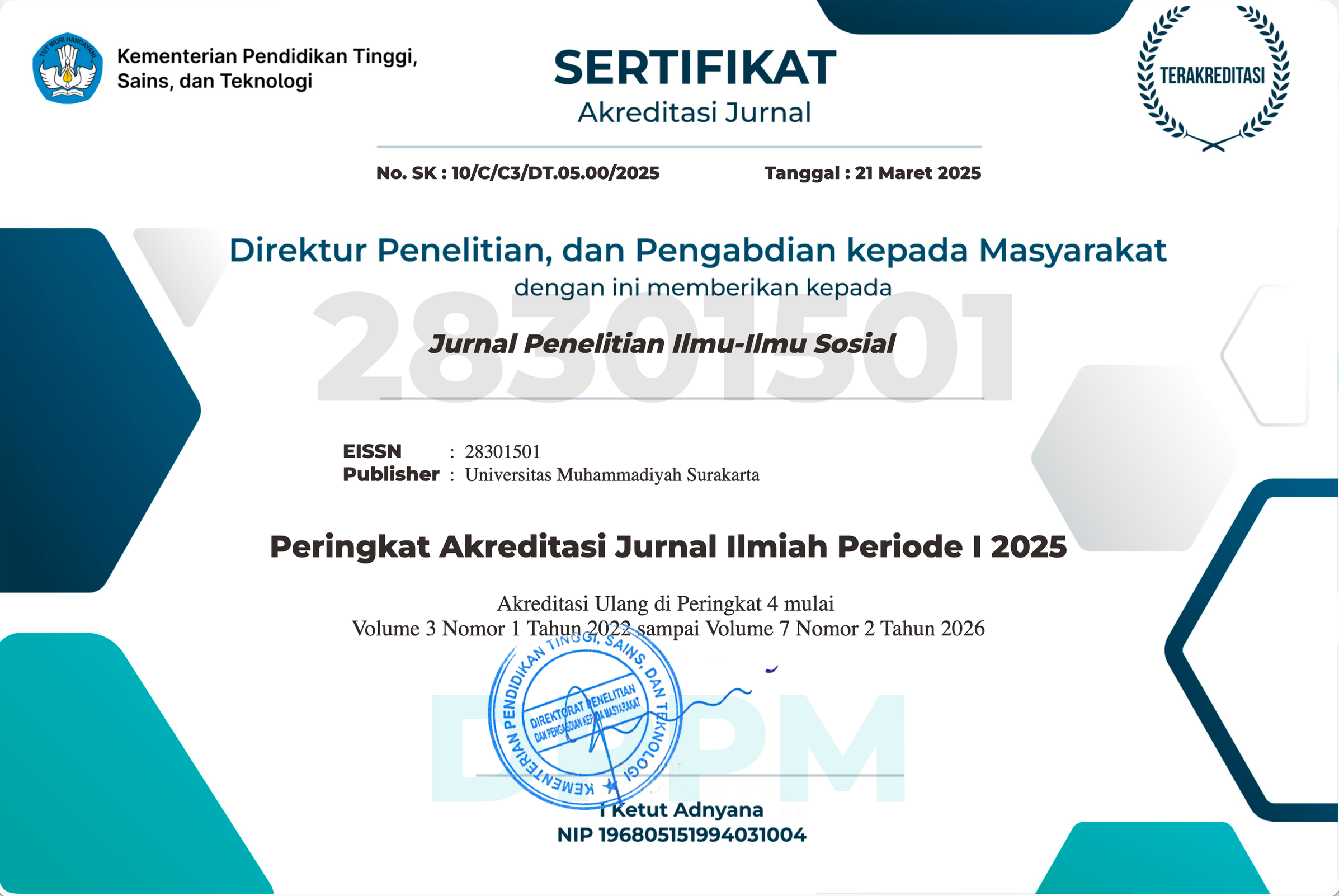Reformulation of Absolute Judicial Review Authority in the Constitutional Court to Uphold the Principle of Constitutional Supremacy
DOI:
https://doi.org/10.23917/sosial.v4i2.2377Keywords:
constitutional court, constitutional supremacy, judicial reviewAbstract
The Constitutional Court and the Supreme Court's dual-roof judicial review authority has generated new legal complications. The decisions between the Supreme Court and the Constitutional Court often conflict, giving rise to legal uncertainty for justice seekers. Even though judicial review has an important role as an effort to protect the constitutional rights of citizens who are disadvantaged over the existence of norms of legislation established by the government. Through the judicial review mechanism, there is a mechanism to rectify the norms of laws and regulations to comply with the basic legal norms, namely the Constitution. However, the practice of judicial review so far in Indonesia seems ineffective because of the two-roof design at the Supreme Court and the Court. Therefore, reforming judicial review under one roof of the Constitutional Court is an alternative idea to find ways to solve existing problems. This article attempts to provide insight into the model of judicial review in Indonesia and the reformulation of judicial review authority under one roof of the Supreme Court of Justice to uphold the principle of constitutional supremacy. The study employed normative legal research methods. This study offers a reformulation of judicial review authority under one roof of the Constitutional Court. The results of this study reveal that the authority of judicial review under the two roofs of the Supreme Court and the Court has given rise to legal problems, such as conflicting decisions, which result in legal uncertainty. Ultimately, this article provides an alternative idea, namely the reformulation of judicial review authority under one roof of the Constitutional Court to create legal certainty and uphold the principle of constitutional supremacy.
Downloads
References
Abraham, H. J. (1982). The Judicial Process: An Introductory Analysis of the Courts of the United States, England, and France. The American Journal of Comparative Law, 30(4), 684–688.
Andreescu, M., & Puran, A. (2018). Principle of the Supremacy of the Constitution. Some Legal Consequences. Jurnalul de Drept Si Stiinte Administrative, 9(1), 19–39.
Anggono, B. D. (2020). Pokok-Pokok Pemikiran Penataan Peraturan Perundang-Undangan di Indonesia (1st ed.). Penerbit Konstitusi Press.
Aris, T. W. (2020). Urgensi Judicial Review Satu Atap oleh Mahkamah Konstitusi. De Jure Jurnal Ilmiah Ilmu Hukum, 1(2), 142. https://doi.org/10.33387/dejure.v1i2.1930
Asshiddiqie, J. (2014). Konstitusi dan konstitusionalisme indonesia (2nd ed.). Sinar Grafika.
Asshidiqie, J. (2005). Model-Model Pengujian Konstitusional di Berbagai Negara (2nd ed.). Konstitusi Press.
Asshidiqie, J. (2006). Perihal Undang-Undang (1st ed.). Konstitusi Press.
Asshidiqie, J. (2011). Gagasan Negara Hukum Indonesia.
Chalid, H. A. (2017). Dualism of Judicial Review in Indonesia: Problems and Solutions. Indonesia Law Review, 7(3), 367–394. https://doi.org/10.15742/ilrev.v7n3.353
Garner, B. A. (2004). Black’s law dictionary (8th ed.). St. Paul, MN : Thomson/West.
Gumbira, S. W. (2016). Problematika Peninjauan Kembali dalam Sistem Peradilan Pidana Pasca Putusan Mahkamah Konstitusi dan Pasca SEMA RI No. 7 Tahun 2014 (Suatu Analisa Yuridis dan Asas-Asas dalam Hukum Peradilan Pidana). Jurnal Hukum & Pembangunan, 46(1), 106–119.
Hoesein, Z. A. (2005). Pengujian peraturan perundang-undangan menurut Konstitusi Indonesia. Universitas Indonesia.
Hofi, Moh. A. (2021). Judicial Review Satu Atap di Mahkamah Konstitusi Sebagai Refleksi terhadap Problematika dan Tantangan Kekuasaan Kehakiman di Indonesia. HUKMY : Jurnal Hukum, 1(2), 221–234. https://doi.org/10.35316/hukmy.2021.v1i2.221-234
Huda, N. (2008). UUD 1945 dan Gagasan Amandemen Ulang . Rajawali Pers.
Huda, N. (2018). Kekuatan Eksekutorial Putusan Mahkamah Konstitusi (1st ed.). FH UII Press.
Kelsen, H. (2005). General Theory of Law and State (1st ed.). Routledge.
Kodiyat MS, B. A., & Sinaga, E. I. M. (2019). Kewenangan Mahkamah Konstitusi dalam Perlindungan Hak Konstitusional Warga Negara Melalui Konstitusional Complaint. DE LEGA LATA: Jurnal Ilmu Hukum, 4(1), 160–174. https://doi.org/10.30596/dll.v4i2.3174
Kurus, arsil. (2017, December). Statistik Data Perkara Mahkamah Agung. Lembaga Kajian & Advokasi Independensi Peradilan. https://leip.or.id/statistik-data-perkara-mahkamah-agung/
Lailam, T. (2018). Penataan Kelembagaan Pengujian Norma Hukum di Indonesia. Jurnal Konstitusi, 15(1), 206–229. https://doi.org/10.31078/jk15110
Mahfud. (2012). Konstitusi dan Hukum dalam Kontroversi Isu (3rd ed.). Rajagrafindo Persada.
Marzuki, M. (2017). Penelitian Hukum: Edisi Revisi. Prenada Media.
Palguna, I. D. G. (2013). Pengaduan Konstitusional (Constitutional Complaint) : Upaya Hukum Terhadap Pelanggaran Hak-Hak Konstitusional Warga Negara (1st ed.). Sinar Grafika.
Rahkmat, M. (2018). Konstitusi dan Kelembagaan Negara. Logoz Publishing.
Satory, A., & Sibuea, H. P. (2020). Problematika Kedudukan dan Pengujian Peraturan Mahkamah Agung Secara Materiil sebagai Peraturan Perundang-Undangan. 6(1), 1–27. https://journal.unpak.ac.id/index.php/palar
Siahaan, M. (2009). Peran Mahkamah Konstitusi dalam Penegakan Hukum Konstitusi. Jurnal Hukum Ius Quia Iustum, 16(3), 357–378. https://doi.org/10.20885/iustum.vol16.iss3.art3
Simamora, J. (2014). Analisa Yuridis terhadap Model Kewenangan Judicial Review di Indonesia. Mimbar Hukum - Fakultas Hukum Universitas Gadjah Mada, 25(3), 388. https://doi.org/10.22146/jmh.16079
Soekanto, S., & Mamudji, S. (2015). Penelitian Hukum Normatif : Suatu Tinjauan Singkat (17th ed.). Rajawali Pers.
Sulaiman, K. F. (2017). Teori dan Hukum Konstitusi. Penerbit Nusa Media.
Tiara Herlinda, & Zuhri, M. (2017). Mekanisme Pemeriksaan Dalam Persidangan Hak Uji Materiil di Mahkamah Agung. Jurnal Ilmiah Mahasiswa Bidang Hukum Kenegaraan, 1(2), 60–70.

Downloads
Submitted
Accepted
Published
Issue
Section
License
Copyright (c) 2023 Rivan Hidayat, Ritika Sahzana Adiba

This work is licensed under a Creative Commons Attribution 4.0 International License.















